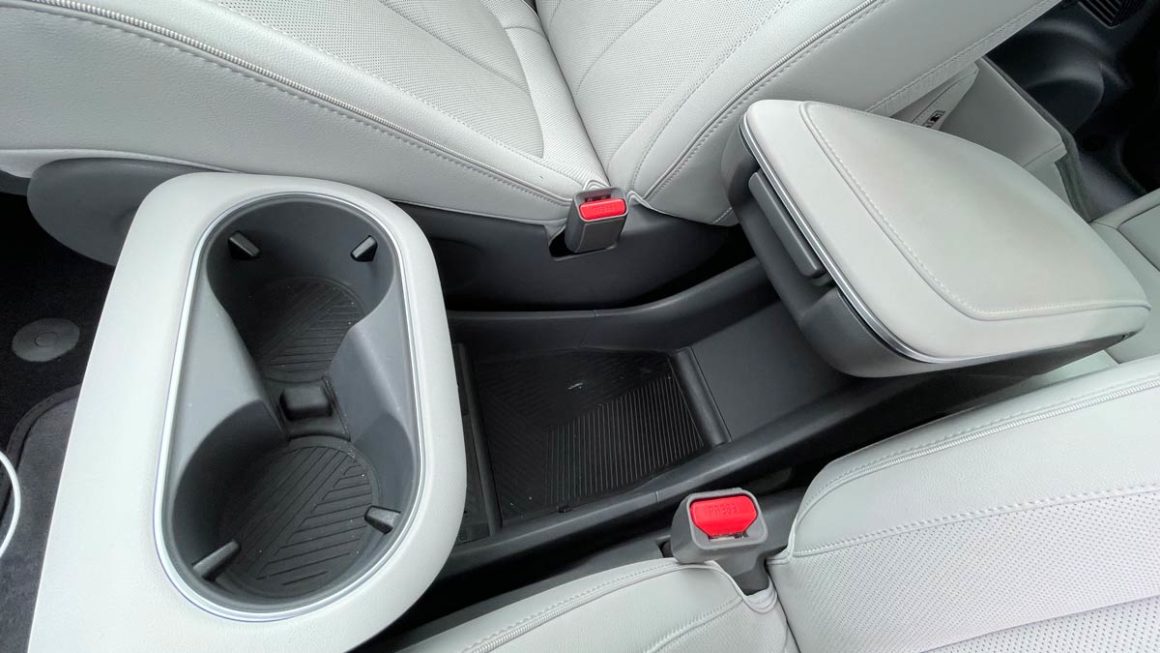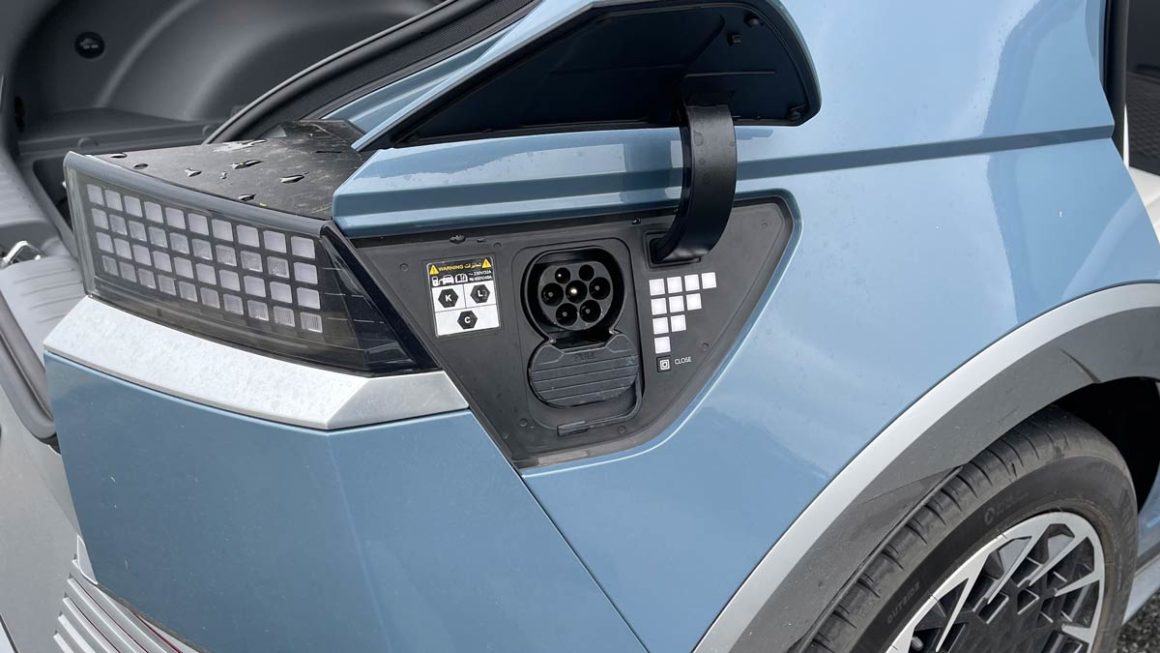The good: Spacious and flexible, thoughtful inclusions, improved auto-steering
The bad: No USB-C port, mechanical bonnet lever, hit and miss auto-parking
The Ioniq 5 hit the Australian market in late 2021. It is Hyundai’s first ground-up electric car, built on its e-GMP platform that it shares with the Kia EV6 and will also share it with other incoming models in the Ioniq series.
In Australia, it is available with either a single-motor on the rear axle or dual-motor formats, with a 72.6kWh battery that offers 451km range in the RWD version and 430km in the AWD version (based on the WLTP rating).
With sustainable interiors, made from sugar cane components, crushed PET bottles and the like, it is available in a range of six exterior colours (Atlas White, Phantom Black, Lucid Blue, Digital Teal-Green, Galactic Grey, and Gravity Gold) and a variety of colour combination choicess on the inside.
These include Obsidian Black, two-tone Dove Grey/Dark Pebble Grey, or two-tone Dove Grey/Dark Teal leather.
The first variant I’ve had the opportunity to test drive is the RWD, in Lucid Blue with the Dove and Dark Pebble Grey two-tone.
Ioniq 5 first impressions
My first impression getting into Ioniq 5 is that Hyundai has completely rethought how to enter a new “space age” of electrification.
And by space, I mean not just futuristic, but literally spacious.
It is worlds apart from the Ioniq Electric fastback, which is available in three electrified powertrains including hybrid and plug-in hybrid.
It is also distinctly set apart from the Kona EV. which is based around a Hyundai Kona with the combustion engine removed and replaced with an electric drivetrain. The result in the Kona is one of compromise, whereas the Ioniq 5 is spacious and incredibly flexible, as we shall see.
The Ioniq 5 also speaks volumes in its exterior design. It is distinctly futuristic with its Pony-inspired LED lights and angular design edges. I thought I would find this a boxy car but – as The Driven editor Giles Parkinson has noted – it is something of a tardis.
It would not be an exaggeration to say this is perhaps the most thoughtful car I’ve ever had the pleasure of driving: Hyundai has put a great deal of thought into making every aspect of the user experience of this car.
It is no wonder that this car has won many car of the year awards. From the moment you step into it, its spacious interior and minimalist design are an invitation to sit back, relax and enjoy the drive.
Spacious, flexible interior
A flat floor with features like a moveable centre console that doesn’t join up with the front dash, and a door handle that is actually an elbow rest inset into the doorframe gains a couple of inches extra space for the arms.
Between the seats is a space for a sizeable handbag, or for other gear. Two generous coffee cup holders sit at the top and at the back is a fairly decent sized storage space.

Driver interface and energy consumption
Other thoughtful inclusions in the car include two wide screens side by side the one in the centre is a touch screen.
The interface colour scheme is in tune with the interior of this model which is very light theme with cream upholstery and pale blush pink sides where the speakers are and a soft gray across the dash.
The screens integrate into this effortlessly with a pale interface that is designed in a way that is fairly intuitive, including a row of buttons to access car controls on the touchscreen and beneath that are climate controls.

The centre console display has continuous information on energy consumption. I used an average of 17.4 kWh/100km in a relatively hilly area. Toggling through the display choices, it tells me I used an average of a continuous average going uphill at 19.7kWh/100km.
If you are driving conservatively in a non-hilly area, you can quite easily get about 16kWh/100km.

Smartphone connectivity
There are some idiosyncrasies with finding certain aspects of the interface. For example, the car does have Android Auto and Apple CarPlay you have to have the phone plugged in via a USB-A cord.
There are no USB-C cords in this car which I thought was a little odd. It would be good to see Hyundai add that down the track, as Kia has in the EV6.
Once you connect it via the USB-A port, you can activate Apple CarPlay or Android Auto. This can be accessed either via using voice control, or hitting the home button to bring up the car’s interface and selecting the phone interface option. The voice control button is on the steering wheel, and once you press that, then you can activate your phone’s voice assistant.
I had trouble with using the Apple Maps navigation: for some reason, every time I tried using Apple Maps via my smartphone assistant, it cut out. The inbuilt navigation that Hyundai has provided is satisfactory, but you can’t use voice control to activate it.
So, I was left with asking Siri to open Google Maps, and then clicking or pressing Search and the microphone to then be able to speak the destination in as I drove.
At that point, everything was fine. Because it is Google Maps, you then can use satellite navigation. It’s a seamless experience with what I would use on my phone normally for navigation in a car.
Driver modes and regen
You’ve also got a button for Drive Mode, which will change the amount of power you can access at any one time and it’ll also change the display so you can tell what mode you’re on quite easily.
It has three driving modes: Eco, Normal and Sport. The RWD Ioniq 5 isn’t a high-performance car by any means, and its acceleration from 0-100km/hr will take 7.4 seconds.
But Sport mode will give you enough power to get out in front of other cars at the traffic lights when the lights turn green. It certainly has enough power to get you up a hill without slowing down.
The car has five regen levels, from i-Pedal (which will make the car roll to stop when you take your foot off the pedal,) down to zero, at which point the car will simply cruise down the road with no braking unless you use your foot pedal.
Battery and charging
The Ioniq 5 has a pretty large 72.6kWh battery. When full, the car said it had 440 kilometres of range which is not far off the 451km WLTP official range.
The CCS2 charge port is on the back right of the car, and offers ultra-fast charging thanks to its 800-volt architecture. I didn’t get to test the 350kW top charge rate, however: as our local 350kW fast charger is grid constricted to 84kW, this will have to wait for another time.

There is one disappointment with the charging experience: the car doesn’t offer any great deal of information on the display when the car’s charging.
If you get in and turn press the ON button (without turning the whole car on) it will display some info, but it is quite small. It would be nice to see the Ioniq 5 display the charging info in a much larger format in a way that can be seen from the outside of the car.
Driver assistance
The Ioniq 5 has quite good driver-assist functions as well. Blind-spot monitoring gives you a red light alert in the side mirrors when you put the indicator on if there is a car on your real left or right. In particular, I liked the virtual mirror display on the centre console on the screen behind the steering wheel.
It’s not in a disconcerting place, as I’ve found with the Tesla (because the Model 3 doesn’t have a steering wheel screen, it is placed awkwardly in the centre dash screen.)

The Ioniq 5 also has lane centring, and adaptive cruise control: in effect, an Autopilot-like experience.
The lane-keeping is greatly improved from what I experienced in the Kona Electric. The Kona Electric that I test drove in 2018 tended to bounce from one side of the lane to another. If it got too close to one side, it was gradually moved back to the other side and slowly zigzagged down the road.
The Ioniq 5 has pretty much got it spot on. It just steers its way down the road. However, there is still one aspect of the driver assistance that Hyundai needs to work on, and that is that it is a little bit too gung-ho when turning. Once the car recognises there’s a corner it starts turning the wheel, but it tends to turn too far and actually turns into the lane marking, setting off the lane guidance alerts.
When the car leaves the lane it emits a gentle beep-beep-beep, which is not jarring. But it is enough to alert you to the fact that you need to correct the car’s steering.
Spacious and flexible seating
Other fantastic features of this car include a very flexible seating system. With electronic back seats that move back and forwards, you can make a choice between how much cargo space you need or giving your passengers extra legroom.
The car is spacious enough to offer equal amounts of both. You can also put the front seats right back and open up the sunroof, put the open fire soundscape on, and stare at the stars.

This car is not just about getting from A to B: its about living, a sense of having a loungeroom-on-wheels.
As a crossover SUV-style vehicle, getting in and out is a very easy affair. Because there’s so much space in both the passenger front row and back row, there’s plenty of room for getting little kids in and out of toddler seats, for example.

Frunk and cargo space
The flexible seating means in addition to the 527 litres of rear cargo space, you can fold down the back row seating to get 1,587 litres total.
Under the bonnet, there is up to 57 litres extra space – and notably, this is where Hyundai has hidden the vehicle-to-load (V2L) adaptor.

Unfortunately, this time around I didn’t have a chance to use the V2L capability – although you can read about it in action here and here.
Suffice to say it will be the first thing I try out next time around when we test drive the AWD Ioniq 5.

If there were anything to criticise (and there isn’t a lot), it would be the fact that the Ioniq 5 (as well as the EV6 for that matter) has a lever to open the frunk. For a car that seems to look forward to the future, to find something so mechanical conveys a small amount of cognitive dissonance.

Relaxing drive
I’ve spent the last few days driving up and down the coast in this car. And for someone who tires easily from that sort of drive, particularly in the rain, I have to say it’s been a pleasure.
The whole sense of being in the car is one of relaxation and safety which is accentuated by the car’s handling. Going around corners there is very little rolling (I’m told the tuning in the EV6 is even better – stay tuned on that.)
The car is quite wide and you certainly feel that it adds to the sense of stability.
Another little aspect is that Hyundai has thoughtfully included ambient sound options. Instead of choosing to listen to the radio or putting on some music you can you can choose between a number of soundscapes.
These include sounds of a forest or ocean waves, a snowy mountain slope or a cafe, or the patter of raindrops on a rainy day. These might not be everyone though – after a while of having the open fireplace on my partner asked if we could turn the bushfire off.
And I imagine the rainy day soundscape would not be relaxing for those in my flood-affected community.
Instead, I sat back and listened to the sounds of insects chirping in the forest, and enjoyed the sense of not being stuck in bumper-to-bumper traffic on a grey rainy day.
It is no wonder Hyundai are having no trouble selling this vehicle. Aside from the small numbers Hyundai has been able to secure for the local market, there is no wonder why there is plenty of demand.
It is really great to see another carmaker other than Tesla finally enter the market with a fresh approach to the private passenger car.
It has made no compromises, and taken advantage of everything electrification has to offer: from V2L, its spacious and flexible interior and well-thought-out user interface.
Now, just to get the auto park feature to work reliably.

Bridie Schmidt is associate editor for The Driven, sister site of Renew Economy. She has been writing about electric vehicles since 2018, and has a keen interest in the role that zero-emissions transport has to play in sustainability. She has participated in podcasts such as Download This Show with Marc Fennell and Shirtloads of Science with Karl Kruszelnicki and is co-organiser of the Northern Rivers Electric Vehicle Forum. Bridie also owns a Tesla Model Y and has it available for hire on evee.com.au.





